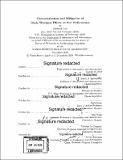| dc.contributor.advisor | Zoltán S. Spakovszky and Edward M. Greitzer. | en_US |
| dc.contributor.author | Lee, Jinwook,Ph. D.Massachusetts Institute of Technology. | en_US |
| dc.contributor.other | Massachusetts Institute of Technology. Department of Aeronautics and Astronautics. | en_US |
| dc.date.accessioned | 2020-03-23T18:09:38Z | |
| dc.date.available | 2020-03-23T18:09:38Z | |
| dc.date.copyright | 2019 | en_US |
| dc.date.issued | 2019 | en_US |
| dc.identifier.uri | https://hdl.handle.net/1721.1/124171 | |
| dc.description | Thesis: Ph. D., Massachusetts Institute of Technology, Department of Aeronautics and Astronautics, 2019 | en_US |
| dc.description | Cataloged from PDF version of thesis. | en_US |
| dc.description | Includes bibliographical references (pages 235-240). | en_US |
| dc.description.abstract | The role of surface waviness, arising from carbon composite manufacturing process, on aeroengine fan blade performance is characterized. The mechanisms for laminar-turbulent transition are assessed numerically and experimentally over relevant range of aerodynamic and geometric parameters. The governing mechanism (natural transition triggered by receptivity amplification from surface waviness) is explained based on a newly established numerical framework and validated experimentally. Computations and experiments are performed to assess the surface waviness loss mechanism under a relevant range of aerodynamic and geometric parameters. The major feature, with estimated isentropic efficiency loss up to 1%, is identified to be the movement of the natural transition location due to receptivity amplification, via geometric resonance between the Tollmien-Schlichting wavelength and the surface wavelength. An effective numerical framework, referred to as the extended eN method, is established to assess the occurrence of the start of transition by tracing the energy transfer from freestream acoustic disturbance to initiation and growth of Tollmien-Schlichting waves. A subsonic natural transition wind tunnel was designed and constructed to determine the effects of surface waviness on natural transition. The theoretical amplification of Tollmien-Schlichting waves, and the corresponding transition point movement due to surface waviness, is successfully validated by these experiments. The research contributes to aircraft engine fan blade technology through a new capability to estimate the effect of blade surface waviness on fan performance, characterization of the underlying mechanisms, and design guidelines for improvements of modern carbon composite fan blades. | en_US |
| dc.description.statementofresponsibility | by Jinwook Lee. | en_US |
| dc.format.extent | 240 pages | en_US |
| dc.language.iso | eng | en_US |
| dc.publisher | Massachusetts Institute of Technology | en_US |
| dc.rights | MIT theses are protected by copyright. They may be viewed, downloaded, or printed from this source but further reproduction or distribution in any format is prohibited without written permission. | en_US |
| dc.rights.uri | http://dspace.mit.edu/handle/1721.1/7582 | en_US |
| dc.subject | Aeronautics and Astronautics. | en_US |
| dc.title | Characterization and mitigation of blade waviness effects on fan performance | en_US |
| dc.type | Thesis | en_US |
| dc.description.degree | Ph. D. | en_US |
| dc.contributor.department | Massachusetts Institute of Technology. Department of Aeronautics and Astronautics | en_US |
| dc.identifier.oclc | 1143739529 | en_US |
| dc.description.collection | Ph.D. Massachusetts Institute of Technology, Department of Aeronautics and Astronautics | en_US |
| dspace.imported | 2020-03-23T18:09:37Z | en_US |
| mit.thesis.degree | Doctoral | en_US |
| mit.thesis.department | Aero | en_US |
